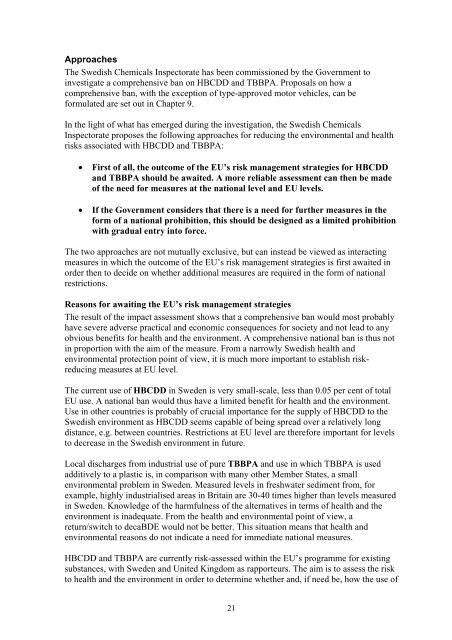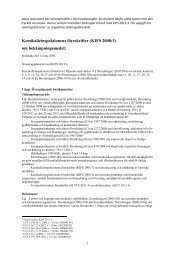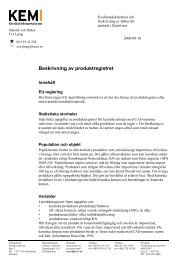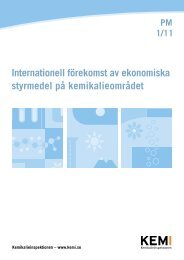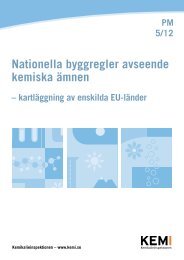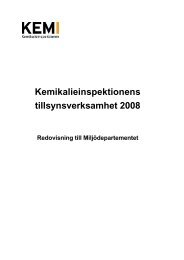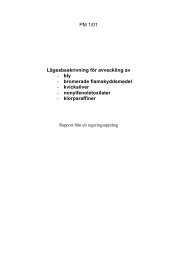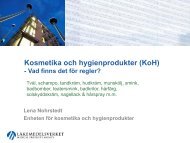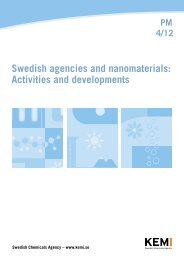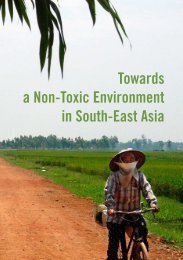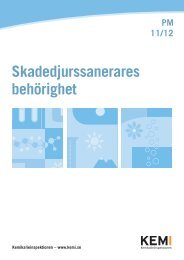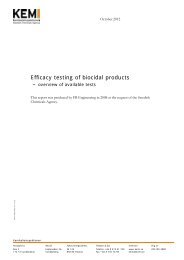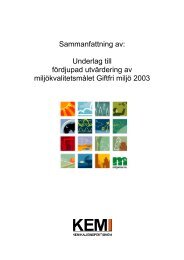KemI Rapport 3/06. - Kemikalieinspektionen
KemI Rapport 3/06. - Kemikalieinspektionen
KemI Rapport 3/06. - Kemikalieinspektionen
Create successful ePaper yourself
Turn your PDF publications into a flip-book with our unique Google optimized e-Paper software.
ApproachesThe Swedish Chemicals Inspectorate has been commissioned by the Government toinvestigate a comprehensive ban on HBCDD and TBBPA. Proposals on how acomprehensive ban, with the exception of type-approved motor vehicles, can beformulated are set out in Chapter 9.In the light of what has emerged during the investigation, the Swedish ChemicalsInspectorate proposes the following approaches for reducing the environmental and healthrisks associated with HBCDD and TBBPA:• First of all, the outcome of the EU’s risk management strategies for HBCDDand TBBPA should be awaited. A more reliable assessment can then be madeof the need for measures at the national level and EU levels.• If the Government considers that there is a need for further measures in theform of a national prohibition, this should be designed as a limited prohibitionwith gradual entry into force.The two approaches are not mutually exclusive, but can instead be viewed as interactingmeasures in which the outcome of the EU’s risk management strategies is first awaited inorder then to decide on whether additional measures are required in the form of nationalrestrictions.Reasons for awaiting the EU’s risk management strategiesThe result of the impact assessment shows that a comprehensive ban would most probablyhave severe adverse practical and economic consequences for society and not lead to anyobvious benefits for health and the environment. A comprehensive national ban is thus notin proportion with the aim of the measure. From a narrowly Swedish health andenvironmental protection point of view, it is much more important to establish riskreducingmeasures at EU level.The current use of HBCDD in Sweden is very small-scale, less than 0.05 per cent of totalEU use. A national ban would thus have a limited benefit for health and the environment.Use in other countries is probably of crucial importance for the supply of HBCDD to theSwedish environment as HBCDD seems capable of being spread over a relatively longdistance, e.g. between countries. Restrictions at EU level are therefore important for levelsto decrease in the Swedish environment in future.Local discharges from industrial use of pure TBBPA and use in which TBBPA is usedadditively to a plastic is, in comparison with many other Member States, a smallenvironmental problem in Sweden. Measured levels in freshwater sediment from, forexample, highly industrialised areas in Britain are 30-40 times higher than levels measuredin Sweden. Knowledge of the harmfulness of the alternatives in terms of health and theenvironment is inadequate. From the health and environmental point of view, areturn/switch to decaBDE would not be better. This situation means that health andenvironmental reasons do not indicate a need for immediate national measures.HBCDD and TBBPA are currently risk-assessed within the EU’s programme for existingsubstances, with Sweden and United Kingdom as rapporteurs. The aim is to assess the riskto health and the environment in order to determine whether and, if need be, how the use of21


